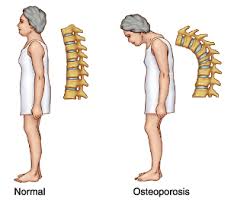Osteoporosis is a condition characterized by weak bones especially in areas like the hips, spine and wrist. It commonly affects older women, although men and women of any age may suffer from it. In the United States alone, more than 40 million people have this disease.
Symptoms
Osteoporosis can be considered a silent disease, as its symptoms won’t become apparent until it progresses into the later stages. Bone loss is gradual and unnoticeable, thus sufferers won’t have any idea that they have osteoporosis until they experience fractures resulting from even a simple strain or bump. Fractures usually happen in the wrist, spine, pelvis, and upper arm.
However, anyone who has osteoporosis can easily break his/her bone. Fractures are quite serious and in some cases, can require hospitalization and prolonged rehabilitation. Osteoporotic bone is thin and brittle, with the patient suffering from stiffness and reduced movement. Osteoporosis in the spine may result to spinal vertebrae collapse resulting to extreme pain in the back, loss of height and spinal deformities.
Causes
 The human bone degrades as we age, although people with osteoporosis experience this process faster. The rapid bone degradation may be due to risk factors like deficiencies in nutrition as well as genetics. Although osteoporosis is not inherited, it tends to run among families who genetically don’t have good or healthy bones. Limited calcium intake is also considered as a major reason why many people suffer from osteoporosis.
The human bone degrades as we age, although people with osteoporosis experience this process faster. The rapid bone degradation may be due to risk factors like deficiencies in nutrition as well as genetics. Although osteoporosis is not inherited, it tends to run among families who genetically don’t have good or healthy bones. Limited calcium intake is also considered as a major reason why many people suffer from osteoporosis.
Lack of vitamin D in one’s diet can also contribute to this condition. Elder women tend to be at a higher risk of getting osteoporosis because of the drop in estrogen levels after menopause. Estrogen slows down the process of bone loss and degradation. Other risk factors of this condition are excessive alcohol intake, cigarette smoking and use of certain drugs like anti-convulsants and corticosteroids.
Treatment
The main drug for treatment and prevention of osteoporosis is bisphosphonate which slows down bone loss while increasing bone mass. One of the more popular bisphosphonate drugs in the market is Fosomax which is available in tablet and solution forms. It is manufactured by Merck & Company. Fosomax strengthens bone mass and prevents the action of the osteoclasts cells that are responsible for old bone removal.
Its main ingredient is alendronate sodium. However, the use of this drug can also cause side effects like heartburn, chest pains, back pain and difficulty in swelling. Some people who take the drugs also experience pain in the thighs, joints and muscles, while others complain of body aches, jaw pain, swelling, and flu-like symptoms like colds and cough.
Prevention
Lifestyle changes are needed in order to decrease the risks of osteoporosis. Maintaining a diet rich in calcium and vitamin D is one of the best ways you can take if you want to avoid this painful condition. Good sources of calcium are milk, yogurt and cheese while vitamin D can be derived through over-the-counter multivitamins. Regular exercises are also helpful such as walking, hiking, jogging and even simple activities like dancing and climbing stairs.
Share This